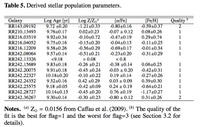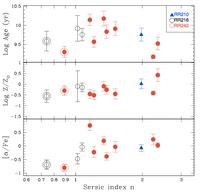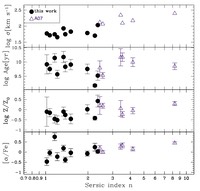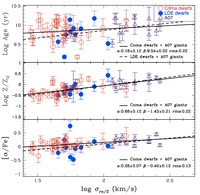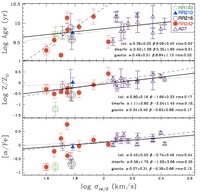Ages, metallicities and [a/Fe] ratios at r<re/2 vs. velocity dispersion. Different symbols indicate the group membership. For comparison, we plot also the stellar population parameters for a selection of galaxies from the bright ETGs of Annibali et al. (2007: open triangles). The solid line indicates the least square linear fit to the (dwarfs + giants) ETG sample. The dashed and dotted lines are separate fits to the dwarf (sre/2< 100 km s-1) and giants samples, respectively.
According to widely accepted Lambda CDM scenario for structure formation, dwarf-size dark matter haloes are the first to form, while large mass haloes build up later through continuous "hierarchical" merging of smaller haloes (e.g. White & Rees 1978; Kauffmann 1996). In this scenario, dwarf galaxies should be the first to form. However, there is strong observational evidence, both in the nearby (Bressan et al. 1996; Thomas et al. 2005; Clemens et al. 2006; Clemens et al. 2009) and more distant Universe (see e.g. Cimatti et al. 2006; Fontana et al. 2006), that more massive early-type galaxies (ETGs) were the first to complete the star formation process, and that star formation terminated later in lower mass systems. This "anti-hierarchical" behavior of the stellar populations as opposed to the hierarchical behavior of the dark matter is commonly referred to as "downsizing". It has been shown that downsizing in the star formation can be reconciled with the Lambda CDM paradigm provided a suitable mechanisms (e.g. AGN feedback, SNe heating) is found to quench star formation at earlier times in more massive ETGs (Granato et al. 2004; De Lucia et al. 2006).
Another issue is the role played by the environment on galaxy evolution. The influence of environment is testified by the presence of the well known morphology-density relation, according to which early-type and morphologically undisturbed galaxies are preferentially located in high density environments (e.g. Oemler 1974; Bamford et al. 2009) and on the star-formation density relation (e.g. Lewis et al. 2002; Haines et al. 2007).
Th effect of the environment on galaxy evolution is expected to be stronger for dwarf galaxies, because of their lower mass. Low-mass galaxies re more susceptible to environmental effects due to their shallow potential well that facilitates the removal of the gas from the galaxies.
Here we present the stellar population properties of 13 dwarf early-type galaxies residing in E+S systems (see Grutzbauch et al. 2009), i.e. poor groups of galaxies observed with VIMOS@VLT.
Methods
Ages, metallicities and [a/Fe] ratios were derived within an re/2 aperture from the Lick indices Hb, Mgb, Fe5270 and Fe5335 through comparison with our simple stellar population models (SSP) accounting for variable [a/Fe] ratios.
Results
For a fiducial subsample of 10 early-type dwarfs we derived the median values and scatter around the medians of 5.7+-4.4 Gyr, -0.26+-0.28, and -0.04+-0.33 for age, logZ/Zsolar and [a/Fe], respectively. For a selection of bright ETGs, from the Annibali et al (2007) sample residing in comparable environments we derive median value of 9.8+-4.1 Gyr, 0.06+-0.16, and 018+-0.13 for the same stellar population parameters. It follows that dwarfs are on the average younger, less metal rich, and less enhanced in the a-elements than giants, in agreement with the extrapolation to the low mass regime of the scaling relations derived from giants ETGs. We also find correlation with morphology, in the sense that the metallicity and the [a/Fe] ratio increase with the Sersic index n or with the bulge-to-total light fraction B/T. The presence of a strong morphology-[a/Fe] relation appears in contradiction to the possible evolution along the Hubble sequence from low B/T (low n) to high B/T (high n) galaxies. We also investigate the role played by environment comparing the properties of our LDE dwarfs with those of Coma red passive dwarfs from the literature. We find possible evidence that LDE dwarfs experienced more prolonged star formation than Coma dwarfs, however larger data samples are needed to draw more firm conclusions.
more details in
Annibali F., Grutzbauch R., Rampazzo R., Bressan, A., Zeilinger W.W.
Nature vs. nurture in the low density environments:
structure and evolution of early-type dwarf galaxies in poor groups
2011, A&A, 528, A19
